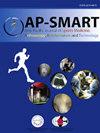Does hip bone morphology differ depending on the presence of cam lesions in borderline developmental dysplasia of the hip?
IF 1.4
Q3 ORTHOPEDICS
Asia-Pacific Journal of Sport Medicine Arthroscopy Rehabilitation and Technology
Pub Date : 2025-07-01
DOI:10.1016/j.asmart.2025.06.001
引用次数: 0
Abstract
Background
The purpose of this study was to divide patients with borderline developmental dysplasia of the hip (BDDH) into two groups according to the presence of Cam lesions, and compare radiographs related to bone morphology between them.
Methods
We retrospectively analyzed consecutive patients with BDDH who underwent hip arthroscopy (HA) or periacetabular osteotomy (PAO) at our institution between October 2013 and October 2019. The patients were classified into two groups according to the presence of Cam lesions. Radiographic measurements including lateral center-edge angle (LCEA), acetabular roof obliquity (ARO), cliff sign, femoral epiphyseal acetabular roof (FEAR) index, vertical center anterior angle (VCA), and Sourcil Index were compared between the two groups. The cutoff values were calculated using a receiver operating characteristic curve.
Results
Sixty-nine hips were analyzed in this study (Cam+: 34, Cam-: 35). The ARO and FEAR index were significantly higher in the Cam-group (P < 0.001, P < 0.001). The LCEA, VCA, and Sourcil Index was significantly lower in the Cam-group than that in the Cam + group (P < 0.001, P < 0.001, P < 0.001). The cutoff values were 21.0° for LCEA, 15.1° for the ARO, 22.5° for the VCA angle, −2.2° for the FEAR index, and 49.5° for the Sourcil Index.
Conclusion
Patients with BDDH exhibited significant differences in bone morphology depending on the presence of Cam lesions. Moreover, those without Cam lesions displayed similarities to patients with DDH.
髋部骨形态是否会因髋部边缘发育不良的cam病变而有所不同?
本研究的目的是将髋关节交界性发育不良(BDDH)患者根据是否存在Cam病变分为两组,并比较两组患者的骨形态学相关x线片。方法回顾性分析2013年10月至2019年10月在我院接受髋关节镜(HA)或髋臼周围截骨术(PAO)治疗的连续BDDH患者。根据有无Cam病变将患者分为两组。比较两组患者的影像学指标,包括髋臼顶外侧中心边缘角(LCEA)、髋臼顶倾角(ARO)、悬崖征、股骨骺髋臼顶(FEAR)指数、垂直中心前角(VCA)和源指数。利用接收机工作特性曲线计算截止值。结果本研究共分析69例髋关节(Cam+: 34, Cam-: 35)。cam组的ARO和FEAR指数显著高于对照组(P <;0.001, P <;0.001)。Cam-组的LCEA、VCA和Sourcil Index显著低于Cam +组(P <;0.001, P <;0.001, P <;0.001)。LCEA的截止值为21.0°,ARO为15.1°,VCA角为22.5°,FEAR指数为- 2.2°,Sourcil指数为49.5°。结论BDDH患者的骨形态随Cam病变的存在而有显著差异。此外,没有Cam病变的患者与DDH患者表现相似。
本文章由计算机程序翻译,如有差异,请以英文原文为准。
求助全文
约1分钟内获得全文
求助全文
来源期刊
CiteScore
3.80
自引率
0.00%
发文量
21
审稿时长
98 days
期刊介绍:
The Asia-Pacific Journal of Sports Medicine, Arthroscopy, Rehabilitation and Technology (AP-SMART) is the official peer-reviewed, open access journal of the Asia-Pacific Knee, Arthroscopy and Sports Medicine Society (APKASS) and the Japanese Orthopaedic Society of Knee, Arthroscopy and Sports Medicine (JOSKAS). It is published quarterly, in January, April, July and October, by Elsevier. The mission of AP-SMART is to inspire clinicians, practitioners, scientists and engineers to work towards a common goal to improve quality of life in the international community. The Journal publishes original research, reviews, editorials, perspectives, and letters to the Editor. Multidisciplinary research with collaboration amongst clinicians and scientists from different disciplines will be the trend in the coming decades. AP-SMART provides a platform for the exchange of new clinical and scientific information in the most precise and expeditious way to achieve timely dissemination of information and cross-fertilization of ideas.

 求助内容:
求助内容: 应助结果提醒方式:
应助结果提醒方式:


